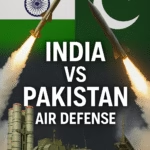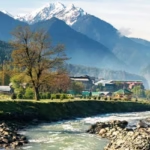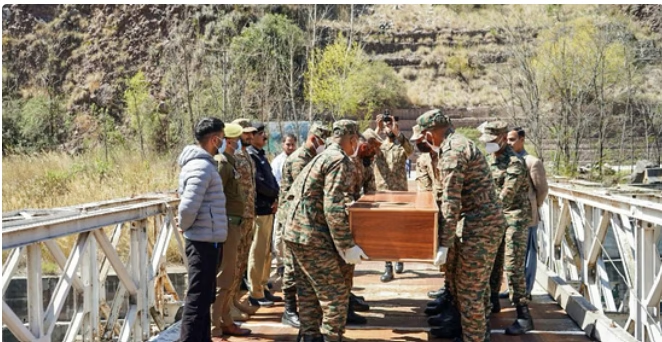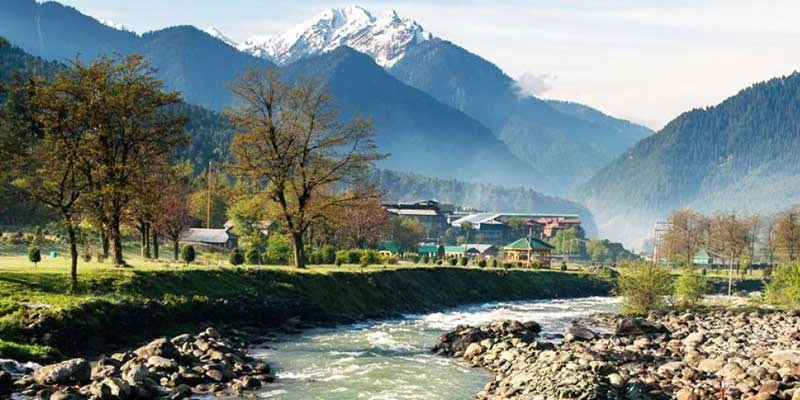The Kaman Bridge, also known as Aman Setu or the Bridge of Peace, recently reopened after six years of closure for a solemn humanitarian purpose: to facilitate the return of the bodies of two young people who drowned in the Jhelum River. This rare moment of cooperation between India and Pakistan amid otherwise strained relations underscores the bridge’s evolving role from a military outpost to a symbol of peace and now a humanitarian corridor. While the reopening was limited to this tragic exchange, it has revived discussions about the potential for restoring cross-border connections that once fostered economic interdependence and reunited divided families. The bridge’s story reflects the complex India-Pakistan relationship—commemorating conflict while simultaneously offering hope for reconciliation.
The Tragic Exchange: A Tale of Star-Crossed Lovers
On March 23, 2025, the Kaman Bridge witnessed a solemn ceremony as Pakistani officials handed over the bodies of two young people from Uri to their Indian counterparts. The deceased, identified as Yasir Hussain Shah (aged 17-23 in various reports) and Asiya Bano (aged 19-20), had tragically jumped into the Jhelum River on March 5 after their families reportedly opposed their plans to marry. This Romeo and Juliet-like tragedy transcended the heavily militarized border, as their bodies drifted across the Line of Control (LoC) into Pakistan-occupied Kashmir (PoK).
Asiya’s body was recovered from the river in Lower Chattar, a neighborhood of Muzaffarabad, while Yasir’s body was found along the Jhelum River bank in Chinari, approximately 12 kilometers from the Chakothi-Uri crossing point. Initial recovery efforts faced significant challenges. Yasir’s body was first spotted near Kaman Bridge on the Indian side on March 20, but strong river currents swept it into PoK-administered territory, complicating recovery efforts.
The handover was conducted with formal dignity. Hattian Bala’s Assistant Commissioner Kamran Khan and Deputy Superintendent of Police Raja Ilyas officially transferred the coffins to Indian authorities between 11:50 am and 12:30 pm, with military officials from both sides present. On the Indian side, senior police and army officers received the bodies at the Kaman Post bridge before they were taken to the sub-district hospital in Uri for medico-legal formalities and finally returned to their grieving families.
The tragedy highlighted not only the personal costs of divided families and cultural restrictions but also the geographical realities of a region where even natural boundaries like rivers bear the burden of political divisions. As one grieving relative lamented, “These children were our future. The river takes so much from us, yet there are no safety measures.” Yasir’s father, Mooz Ali Shah, expressed a universal parental sentiment when he said, “We pray no other parent endures this pain”.
Kaman Bridge: From Military Outpost to Symbol of Peace
To understand the significance of the recent reopening, we must first understand the history and evolution of Kaman Bridge. Located in the Uri sector of Baramulla district, Jammu and Kashmir, the 220-foot structure spans the Jhelum River at the Line of Control between India and Pakistan. Originally established as a strategic military outpost, the bridge derives its name from Lieutenant Colonel Kaman Singh Pathania, who displayed remarkable valor during the 1947 conflict.
The bridge’s physical structure has itself witnessed the region’s tumultuous history. It was significantly damaged during the devastating earthquake of October 8, 2005, when a mountain on the Pakistani side caved in. The rebuilding of the bridge was undertaken by engineers of the Indian Army, and the reconstructed Aman Setu was inaugurated in 2006, marking another chapter in its evolution from a symbol of division to one of cooperation.
In recent years, before its closure in 2019, Kaman Post underwent a remarkable transformation. The Indian Army played a crucial role in this shift, revamping the area with a focus on visitor experience. The post offered panoramic views of the surrounding mountains and valleys, creating breathtaking scenery for photography and nature enthusiasts. A 50-foot-tall Indian flag proudly fluttered at the post, instilling a sense of national pride and patriotism among visitors.
The symbolic transformation was perhaps even more significant than the physical one. What once represented the harsh reality of division gradually evolved into a beacon of hope for peace and reconciliation between two neighboring nations with a complex shared history.
The Bridge of Peace: Connecting Divided Families
The most profound impact of Kaman Bridge came when it was transformed into a vital crossing point for divided families separated by the partition of India and Pakistan in 1947. In 2005, in a move that surprised many, the governments of India and Pakistan agreed to reopen the Jhelum Valley Road, a historic route that had been closed since Partition. This initiative led to the bridge being rechristened “Kaman Aman Setu” – the Kaman Bridge of Peace.
The Srinagar-Muzaffarabad bus service, which utilized the bridge, became a lifeline for families torn apart by the arbitrary border. Though the exact number of families affected by the repeated divisions is difficult to ascertain, the majority of respondents during various studies noted that thousands of such families are spread across the divide. After decades of separation, the opening of the Srinagar-Muzaffarabad route in 2005 rekindled hopes of reunion for these divided families.
Considering that more divided families resided in Jammu and Ladakh regions, a second intra-Kashmir route from Poonch to Rawalakote was opened in June 2006 in the Jammu region. Nevertheless, the impact of these openings cannot be understated. For many families, these crossings represented the first opportunity in generations to embrace loved ones from whom they had been separated by geopolitical circumstances beyond their control.
The emotional impact of these reunions went far beyond individual families, helping to foster a sense of shared humanity that transcended national boundaries and political differences. For a time, it seemed as if the dream of lasting peace might finally be within reach.
Cross-LoC Trade: Economic Lifeline for Border Communities
Beyond the emotional reconnection of families, Kaman Bridge also became a vital conduit for cross-Line of Control (LoC) trade, which commenced in 2008. This trade was a breakthrough Confidence Building Measure (CBM) between India and Pakistan, creating a “peace constituency” and connecting the divided families of Jammu and Kashmir through economic engagement.
The economic impact was substantial. Between 2008 and 2019, cross-LoC trade achieved a cumulative value of over $1.2 billion—a significant amount considering the nature of border economies in Jammu and Kashmir. The trade generated around 170,000 labor days, equivalent to $12 million for laborers, and freight of approximately $88 million. From 2008 to 2019, the volume of trade via the two concerned routes, Uri-Muzaffarabad and Poonch-Rawalakot, accounted for more than INR 7,500 crores, showcasing the economic capital created through this initiative.
This barter trade system engaged multiple stakeholders including traders, laborers, transporters, and others, creating substantial employment opportunities for people living in these often-marginalized border areas. On-the-ground interactions with stakeholders revealed that about 600 merchants and 300 laborers were directly involved in the day-to-day trade operations across the LoC.
The economic impact extended beyond direct participants. Manufacturers and farmers who provided goods for this trade, end consumers who benefited from more affordable products, and shops, restaurants, and mechanics in the border areas all depended on this trade and transit. Economic activity enhanced connectivity for the otherwise isolated border areas of the districts of Poonch and Baramulla, connecting them not just across the LoC but also to other local districts such as Jammu and Srinagar.
Beyond the economic and financial gains, the cross-LoC trade emerged as a flagbearer of peace between India and Pakistan. The initiation of this trade helped bridge the trust deficit between the governments of India and Pakistan as well as between the government in New Delhi and the people of Jammu and Kashmir.
The Closure: Aftermath of Pulwama and Deteriorating Relations
The promising developments through Kaman Bridge came to an abrupt halt following the Pulwama attack on February 14, 2019, which killed 40 CRPF personnel. India’s response included revoking Pakistan’s Most Favoured Nation (MFN) status and suspending bilateral trade. The gates of Kaman Aman Setu were locked after India suspended the bus service between Kashmir and PoK, effectively closing this vital link between divided territories and people.
Later that year, in August 2019, relations deteriorated further when India revoked the special status of Jammu and Kashmir (Article 370), which Pakistan viewed as an “illegal annexation” while India considered it an “internal matter”. Pakistan responded by “unilaterally downgrading” diplomatic relations with India to the “chargé d’affaires level” and “expelled the Indian High Commissioner”.
The closure of Kaman Bridge was not merely symbolic but had tangible impacts on diplomatic relations, trade, and the lives of people on both sides of the LoC. The bustling activity that had characterized the bridge for years fell silent, and the promise of continued connection and reconciliation seemed to fade.
Six Years of Silence: Impact on Local Communities
The closure of Kaman Bridge and the suspension of cross-LoC activities had profound effects on local communities, particularly those in the Uri sector who had come to depend on the economic opportunities generated by cross-border movement and trade.
Local residents reported that after the closure of trade and bus service in the area, people of the entire Uri subdivision witnessed a steep decline in their business. The economic impact was far-reaching: potential freight earnings of INR 5.5 crores from trucks transiting to and fro via the Srinagar-Chakoti route were lost, and traders in Uri could not realize potential profits of INR 15 crores. Additionally, an estimated loss of over INR 85 lakhs was incurred by concerned support staff, daily-wage laborers, middlemen, and agents in the 31 weeks after March 8, 2019.
Labourers were particularly hard hit, with a cumulative wage loss of about INR 160 lakhs – including a wage loss of INR 95 lakhs by the labor at the Salamabad trade facilitation centre and nearly INR 65 lakhs foregone in labor wages at the Srinagar mandi.
Beyond the economic impact, the closure of the bridge had social and psychological effects on communities accustomed to cross-border connections. Families once again found themselves separated, and the hopeful atmosphere that had characterized the region during the period of open borders gave way to renewed tension and uncertainty.
The silence at Kaman Bridge during those six years reflected the broader diplomatic silence between India and Pakistan, as relations remained strained and opportunities for meaningful dialogue diminished. The bridge stood as a potent symbol of both the potential for connection and the reality of division that characterized the complex relationship between the two countries.
India-Pakistan Relations: A Backdrop to the Bridge’s Story
To fully understand the significance of Kaman Bridge’s reopening, we must consider the broader context of India-Pakistan relations during the six years of its closure. The period following the Pulwama attack and the revocation of Article 370 saw bilateral relations reach a nadir, with multiple areas of contention emerging or intensifying.
Disputes over water resources became increasingly prominent, particularly regarding the Kishanganga and Ratle hydroelectric projects. Pakistan alleged that India was violating the Indus Waters Treaty, while India formally requested a “review and modification” of the treaty, a move that “has not gone well with Pakistan”.
Accusations of interference in internal affairs continued from both sides. Pakistan accused India of fomenting unrest in its Balochistan province and supporting separatist movements there, while India accused Pakistan of “radicalising” Kashmiri youth and “internationalising” the Kashmir issue.
A glimmer of hope emerged in February 2021 when India and Pakistan issued a joint statement for the first time in years, announcing that they would observe the 2003 ceasefire along the Line of Control (LoC). The countries agreed to “a strict observance of all agreements, understandings and cease firing along the Line of Control (LoC) and all other sectors with effect from the midnight of February 24-25, 2021”.
However, the durability of this agreement came into question in early 2025, when cross-border firing incidents along the LoC in the south of the Pir Panjal region increased sharply. Reports emerged of “sniping, firing, and attempts by Pakistan’s Border Action Team (BAT) to breach Indian defences”. Indian Army sources maintained that while the ceasefire agreement remained officially intact, these incidents were being dealt with “swiftly at the local level”.
It was against this backdrop of fragile and frequently violated ceasefires, diplomatic estrangement, and mutual suspicion that the decision to reopen Kaman Bridge for the humanitarian purpose of returning the bodies of Yasir Hussain Shah and Asiya Bano was made—a rare moment of cooperation in an otherwise troubled relationship.

The Geopolitical Significance of Kashmir’s Crossings
The reopening of Kaman Bridge, even for a limited humanitarian purpose, raises important questions about the geopolitical significance of Kashmir and its cross-border connections. Kashmir’s strategic location makes it a vital geopolitical asset for both India and Pakistan, with implications that extend beyond bilateral relations to regional and global power dynamics.
Kashmir has a unique geopolitical status due to its location at the crossroads of several important regions: South Asia, Central Asia, and China. Additional importance is given to this region by the access of Pakistan and India to the Arabian Sea, which provides a direct connection with maritime corridors and the Persian Gulf. In today’s globalized world, unhindered traffic both by land and sea is just as valuable as the goods and services themselves that are transported through these corridors.
For India, Kashmir provides a significant position on the map of Central Asia; without it, India would not have a connection to land trade routes. Control of the area provides a valuable advantage in positioning, particularly given the proximity of Tajikistan, which maintains strong ties with Russia.
Pakistan, on the other hand, has a very important strategic position as it lies on the way of the main maritime and land transport connections going from Central Asia and the Middle East to the center of South and East Asia. The country’s strategic significance has been further enhanced by its place along the Belt and Road Initiative (previously known as the Silk Road) and the China-Pakistan Economic Corridor (CPEC).
Cross-LoC connections like Kaman Bridge can be seen as more than just symbolic gestures or humanitarian corridors; they represent potential economic and strategic linkages that could reshape regional dynamics if fully utilized. As one analyst noted, “Cross-LoC connections can be used as an element of improving India-Pakistan relations. The economic priorities for peace implementation cannot be understated”.
The Reopening: A Humanitarian Gesture amid Tension
The decision to reopen Kaman Bridge after six years of closure was made under tragic circumstances. The drowning of Yasir Hussain Shah and Asiya Bano in the Jhelum River on March 5, 2025, set in motion a sequence of events that would temporarily bridge the divide between India and Pakistan.
When the bodies were recovered in Pakistan-occupied Kashmir—Asiya’s in Lower Chattar, Muzaffarabad, and Yasir’s along the Jhelum River bank in Chinari—it became necessary for authorities on both sides to coordinate their return. This coordination required a level of communication and cooperation that had been largely absent in India-Pakistan relations for the preceding six years.
The handover procedure was formal yet poignant. Hattian Bala’s Assistant Commissioner Kamran Khan and Deputy Superintendent of Police Raja Ilyas from the Pakistani side formally handed over the coffins to Indian authorities between 11:50 am and 12:30 pm on March 23, 2025. Military officials from both sides were present, underscoring the security considerations that continue to characterize any cross-border activity in this sensitive region.
On the Indian side, senior police and army officers received the bodies at Kaman Post bridge before they were taken to the sub-district hospital in Uri for medico-legal formalities. The process reflected both the bureaucratic requirements of international transfers and the humanitarian considerations that prompted this rare instance of cooperation.
The temporary reopening of Kaman Bridge for this purpose highlighted an important reality: despite political tensions and military standoffs, channels for humanitarian exchange remain functional, allowing for cooperation on matters that transcend political differences. The bridge, once a symbol of hope for lasting peace, briefly reclaimed that role as it facilitated this solemn exchange.
Local Reactions: Hope amid Tragedy
The reopening of Kaman Bridge, even under such tragic circumstances, elicited a range of reactions from local communities and officials, many of whom remembered the bridge’s previous role as a vital link between divided territories and families.
NC legislator from Uri, Sajjad Shafi, expressed gratitude to both the Indian and Pakistani governments for facilitating the return of the bodies. “The bodies had got washed away to Pakistan and during the past 48 hours both bodies were retrieved in PoK and now brought back to Uri,” he stated, acknowledging the cooperation that made this possible.
For many residents of Uri, the reopening of











